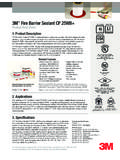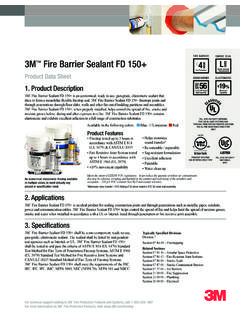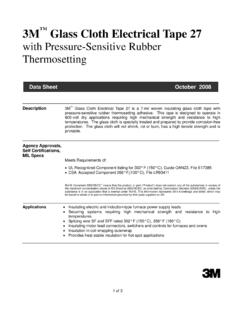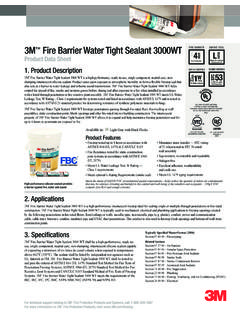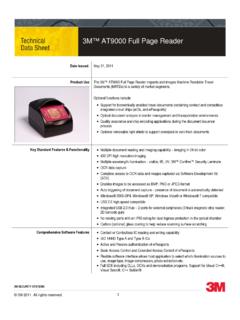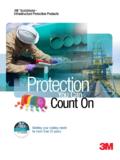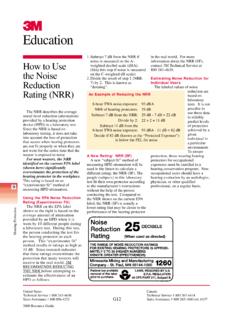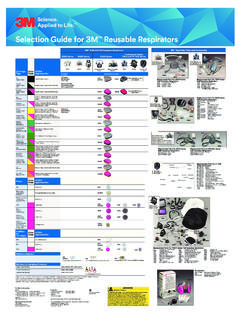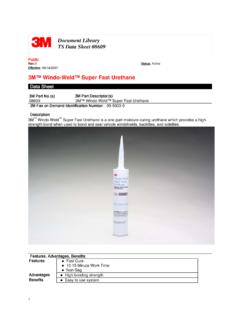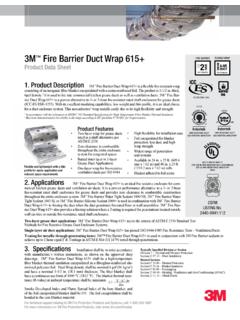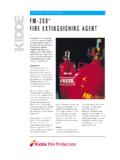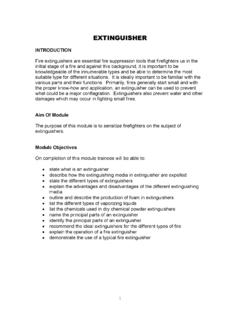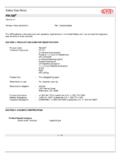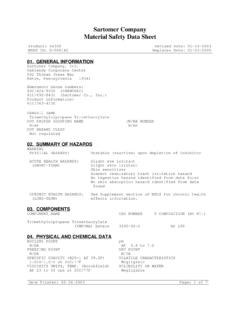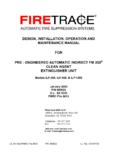Transcription of Preserving room integrity during clean agent …
1 3M Novec 1230 Fire Protection Fluid3 AbstractThe discharge of most halocarbon clean extinguishing agent systems is characterized by a rapid drop in room pressure followed by a positive pressure spike. It is impor tant that these peak pressures do not damage the protected enclosure. This paper reviews the existing data on clean agent system discharge pressures and the factors influencing the magnitude of peak positive and negative pressures, as well as the pressure load limits for enclosures of typical designing a clean agent fire protection system, it is impor tant to consider the potential for any discharge to reduce the str uctural integrity of a protected space. The peak positive and negative enclosure pressures that characterize the discharge of halocarbon fire suppression systems could damage the str uctural members the walling, studs and windows of the protected space, if installed If these str uctural members are damaged during the system discharge, there is no longer a guarantee that the protected enclosure will retain the desired concentration of agent long enough for sufficient suppression of the fire.
2 It is therefore necessar y to understand existing system discharge peak pressure data and the factors influencing the magnitude of both positive and negative peak pressures and how they compare to inter nal pressure load limits for typical construction agent System Discharge PressuresThe distinctive transient pressure dynamics of a clean agent fire suppression system discharge differ depending on agent type. Iner t gas clean agents and one halocarbon clean agent , HFC-23, have high vapor pressures and are characterized by positive enclosure pressures generated upon system discharge. Low pressure halocarbons, however, are characterized by an initial drop in enclosure pressure followed by an eventual transition to positive enclosure pressures. The initial negative pressure spike is the result of the cooling due to the agent s high heat capacity where sensible heat is absorbed during rapid vaporization during discharge.
3 The positive pressure spike that follows is the result of the relatively rapid introduction of the gaseous agent and propellant mass into the fixed enclosure volume. The magnitude of the positive and negative pressure spikes varies from agent to agent . Samples of enclosure pressures during system discharges are illustrated in Figure 1, which displays the enclosure pressures during discharges of three prominent halocarbon clean agents and one inert gas clean agent . Figure 1 shows the contrast between the negative to positive pressure swing for halocarbon system discharges and the single large positive pressure spike typical for iner t results reported in Figure 1 were determined during testing conducted by the room integrity technical subcommittee to the NFPA 2001 Committee in a single enclosure and generated under comparable conditions.
4 Maximum negative and positive pressure values from this testing are given in Table 1. At each agent s minimum design concentration, with similar leakage areas, HFC-227ea tended to yield the greatest positive pressures. FK-5-1-12 produced the greatest negative pressures and the smallest positive pressures. HFC-125 tended to have the smallest negative pressures and the smallest magnitude transition from negative to positive choice, however, is only one of many factors that can impact the magnitude of the negative and positive pressure peaks within the protected space. agent concentration, wall constr uction, enclosure leakage area and location, fire size, humidity and retention time are other impor tant deter minants of the overall pressure Overpressure LimitsUnderstanding the str uctural pressure load limits of the enclosure is important when designing clean agent fire suppression systems.
5 These inter nal enclosure pressure load limits var y with the constr uction type and materials. A steel studded wall, for example, is sturdier than a wood studded wall, but not as strong as a brick wall. As a general r ule, however, non-load bearing walls will be the weakest walls in any given structure. Therefore, non-load bearing wall strengths are considered the threshold for maximum discharge pressures in the design process of clean agent systems. One commonly quoted pressure limit for clean agent systems is a 5 psf (239pa) minimum load requirement for non-load bearing walls given in the International Building Code (IBC), established to address normal variation in continuous room This value is often exceeded as evidenced in comparative testing and without apparent problems or damage reported in practice.
6 Preserving room integrity during clean agent dischargesAmbient Pressure vs. TimeTime (s)-600-400-2002004006008001000005101520 25303540 Enclosure Ambient Pressure (Pa)HFC-227ea (310 cm2 Leakage)HFC-125 (315 cm2 Leakage)FK-5-1-12 (315 cm2 Leakage)IG-541 (590 cm2 Leakage)AgentMax Negative PSF/PaMax Positive PSF/PaF K-5 / 8917. 5 / 3 5 9 Table 1 Representative Peak Pressure ValuesFigure 1 Ambient Enclosure Pressures for Various clean agent System Discharges23M Novec 1230 Fire Protection FluidElectronics Markets Materials Division 3M Center, Building 224-3N-11St. Paul, MN 1-800-251-86343M and Novec are trademarks of 3M. Used under license by 3M subsidiaries and affiliates. Please recycle. Printed in : 8 / 09 3M 2009. All rights reserved. 6870HB 60-5002-0422-13 Product Use : All statements, technical information and recommendations contained in this document are based on tests or experience that 3M believes are reliable.
7 However, many factors beyond 3M s control can af fect the use and per formance of a 3M product in a par ticular application, including conditions under which the product is used and the time and environmental conditions in which the product is expected to per form. Since these factors are uniquely within the user s knowledge and control, it is essential that the user evaluate the 3M product to determine whether it is fit for a par ticular purpose and suitable for the user s method of and Limited Remedy: Unless stated other wise in 3M s product literature, packaging inser ts or product packaging for individual products, 3M warrants that each 3M product meets the applicable specifications at the time 3M ships the product. Individual products may have additional or different warranties as stated on product literature, package inserts or product packages.
8 3M M A K ES NO OTHER WA RR A NTIES, E XPRESS OR IMPLIED, INCLUDING BU T NOT LIMITED TO, A N Y IMPLIED WA RR A NTIES OF MERCH A NTA BILIT Y OR FITNESS FOR A PA RTICUL A R PURPOSE OR A N Y IMPLIED WA RR A NT Y A RISING OU T OF A COURSE OF DE A LING, CUSTOM OR USAGE OF TR ADE. User is responsible for determining whether the 3M product is fit for a particular purpose and suitable for user s application. If the 3M product is defective within the warranty period, your exclusive remedy and 3M s and seller s sole obligation will be, at 3M s option, to replace the product or refund the purchase Of Liability: E xcept where prohibited by law, 3M and seller will not be liable for any loss or damage arising from the 3M product, whether direct, indirect, special, incidental, or consequential regardless of the legal theor y asser ted, including warrant y, contract, negligence or strict liabilit Novec brand is the hallmark for a variety of patented 3M compounds.
9 Although each has its own unique formula and performance properties, all Novec products are designed in common to address the need for safe, effective, sustainable solutions in industry-specific applications. These include precision and electronics cleaning, heat transfer, fire protection, lubricant deposition and several specialty chemical applications. The 3M Novec Brand Family3M Novec Engineered Fluids 3M Novec Aerosol Cleaners 3M Novec 1230 Fire Protection Fluid 3M Novec Electronic Coatings 3M Novec Electronic Sur factantsUnited States 3M Electronics Markets Materials Division 800 810 8513 China 3M China Ltd. 86 21 6275 3535 Europe 3M Belgium 32 3 250 7521 Japan Sumitomo 3M Limited 813 3709 8250 Korea 3M Korea Limited 82 2 3771 4114 Singapore 3M Singapore Pte. Ltd. 65 64508888 Taiwan 3M Taiwan Limited 886 2 2704 9011 For example, in a typical hazard with a 10'-0"( ) high ceiling, a hazard height 75% of the room height designed to a 10 minute hold time in accordance with NFPA 2001 and using design predictions deter mined from conventional room integrity modeling, peak room pressure predictions for both iner t gas and halocarbon systems exceed that limit in most cases.
10 This is assuming a worst case retention scenario where there is 50 % of the leakage high and 50 % of the leakage low in the room . In practice, there exists more leakage high than below, making it easier to achieve hold time, thus reducing resultant peak pressure load limits for carbon dioxide suppression systems, whose pressure dynamics are similar to an iner t gas, are given in the NFPA 12 Standard on Carbon Dioxide extinguishing Systems for various constr uction types. NFPA 12 explains that relief venting, in the form of doors, windows and dampeners, exists in almost all enclosures, and although it cannot be easily quantified, presents sufficient venting for pressures up to 25 psf for light constr uction and 50 psf for nor mal constr have also been made to model the ambient pressure load limits of studded walls based on the stud spacing and the yield or tensile strength of the stud material.
